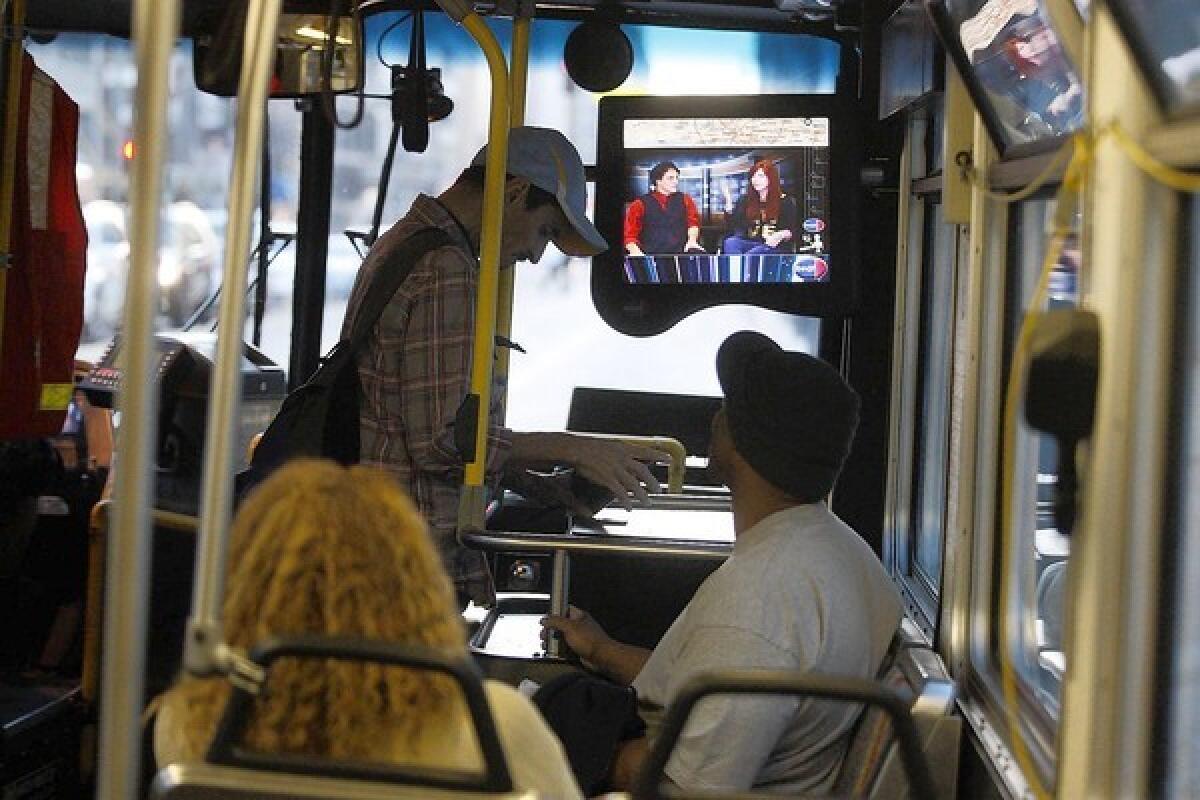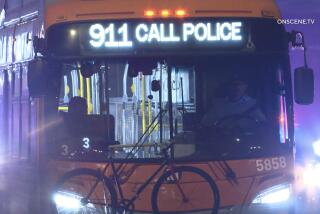KNBC-TV playing to viewers on L.A. County buses

KNBC-TV Channel 4 is taking the bus.
Nearly 1,800 Los Angeles County buses operated by the Metropolitan Transportation Authority have become the latest vehicles for the local TV station’s advertising sales and marketing.
The NBCUniversal-owned station is producing a special daily newscast, featuring weatherman Fritz Coleman and news anchors Chuck Henry and Colleen Williams, that plays on 19-inch TV monitors bolted into Metro buses.
Additional NBCUniversal content, including bits from Jay Leno on “The Tonight Show,” celebrity gossip from “Access Hollywood,” and news delivered in Spanish by Telemundo anchors, helps round out an hourlong TV program that repeats throughout the day aboard the buses.
ON LOCATION: Where the cameras roll
The venture is part of NBCUniversal’s push to provide local content for video screens at gas stations and, on the East Coast, in trains and taxis.
And it’s giving a lift to a San Fernando Valley firm, Transit TV, which holds the contract with MTA.
For bus rider and Los Angeles native Emmett Cutler, 56, who takes the Broadway line through downtown L.A., the TVs can be a diversion during his daily commute.
“You have to get up real early to catch the news at home, and this shows you a variety of things, including weather, maps and news for your area,” Cutler said during a bus ride last week. “I like it.”
PHOTOS: Celebrities by The Times
It’s been a bumpy ride for Transit TV, which began installing TV monitors in Metro buses about six years ago. The original owner, a Canadian company that publishes the Toronto Star newspaper, spent tens of millions of dollars outfitting buses in several markets, including Los Angeles, Chicago and Orlando, with the technology and TV screens.
The Canadian company put its cash-strapped U.S. subsidiary, Transit TV, into Chapter 7 bankruptcy four years ago.
The MTA TV screens went dark until L.A. company Tezo Systems Unlimited Inc. took over Transit TV, becoming its parent company. In 2010, Tezo received permission from Metro to operate the service.
Tezo owner Maurice Vanegas, who got his start as a bus driver and mechanic, discovered plenty of problems under the hood.
“It’s been challenging financially,” Vanegas said, acknowledging that his firm has invested “a couple of million” trying to fix technical issues and provide the content.
But advertisers were scarce.
“We have a great product, and a captive audience to boot,” Vanegas said. “But the tea leaves showed that we needed to associate ourselves with a media company that does this for a living.”
Enter KNBC, whose parent company had experimented with providing content for taxis and trains in New York and Philadelphia, as well as for gyms and gas station pumps in nearly 60 cities, including four locations in L.A.
“We are putting a lot of effort into this,” said Shawn Makhijani, senior vice president of business development for NBCUniversal-owned TV stations. “We would like to be the provider of news and information whenever and wherever our viewers are. And the buses provide a great, captive environment.”
About 80% of Metro’s 2,228 buses are equipped with TVs. The county agency said it receives about $100,000 in revenue annually from Transit TV.
The KNBC evening news team last month began producing a separate newscast for the buses, which is digitally transmitted to the buses late at night when they are parked at bus barns for use the next day.
“We are trying to make sure the stories we present are big enough, and important enough, to interest a diverse audience,” said Todd Mokhtari, KNBC’s vice president of news.
FULL COVERAGE: Fall TV preview 2013
For KNBC, the effort delivers on Comcast Corp.’s promise to invest more heavily in local news. Comcast took operating control of NBCUniversal nearly three years ago from General Electric Co., which had slashed spending at local NBC stations during a slump in advertising.
But in the last year, KNBC has increased the size of its staff, stepped up its Inland Empire coverage, leased its own helicopter and began producing a noon newscast. Mokhtari said the added resources enabled the station to tackle the bus project.
“We are serving a much more diverse audience on the transit system,” he said.
Advertising buyers said they are intrigued by the programming upgrade.
“There is a much bigger opportunity out there for advertisers,” said Sharon Cooper, associate media director at ad firm Grupo Gallegos in Huntington Beach. “You have so many people riding the buses every day.”
PHOTOS: Leading ladies of the fall TV season
Mark Amorello, associate media director for ad buying firm Starcom USA, agreed, saying, “More and more consumers are getting their information outside of the home, and this is just one more platform to reach viewers.”
Metro averaged 1.2 million bus boardings on weekdays in September. More than half the county’s bus passengers — 56% — identified themselves as Latino, according to a 2012 ridership survey. African Americans make up about 23% of the ridership, with whites, Asians and Pacific Islanders comprising nearly 18%.
PHOTOS: Cable versus broadcast ratings
The strong contingent of Latino passengers has prompted a debate among advertisers, Transit TV and KNBC about what language should dominate. Currently, the KNBC-produced Transit TV hour of programming includes just a few minutes of Spanish-language news from Telemundo, partly because Vanegas believes “the content should be in English.”
Cooper thinks otherwise.
“I understand there’s a fear of alienating people who do not speak Spanish, but they need to look at the population that is riding the buses,” she said. “More than two or three minutes of Spanish news would be appropriate.”
NBCUniversal’s Makhijani said more Spanish-language content might be rolling out soon.
More to Read
From the Oscars to the Emmys.
Get the Envelope newsletter for exclusive awards season coverage, behind-the-scenes stories from the Envelope podcast and columnist Glenn Whipp’s must-read analysis.
You may occasionally receive promotional content from the Los Angeles Times.








